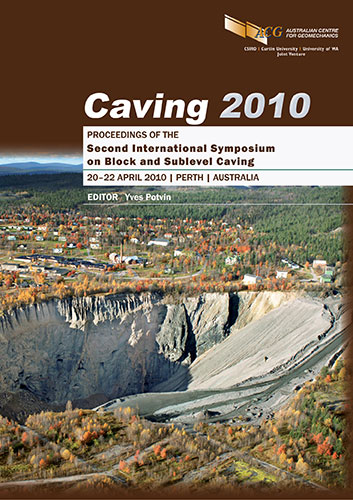Design and implementation of a damage assessment system at Argyle Diamond’s block cave project

|
Authors: Fernandez, F; Evans, P; Gelson, R |
DOI https://doi.org/10.36487/ACG_rep/1002_1_Fernandez
Cite As:
Fernandez, F, Evans, P & Gelson, R 2010, 'Design and implementation of a damage assessment system at Argyle Diamond’s block cave project', in Y Potvin (ed.), Caving 2010: Proceedings of the Second International Symposium on Block and Sublevel Caving, Australian Centre for Geomechanics, Perth, pp. 65-81, https://doi.org/10.36487/ACG_rep/1002_1_Fernandez
Abstract:
A fundamental concept of rock mechanics establishes that damage may occur as a result of rock mass disturbance due to excavation. Experience in block and panel caving mines indicates that the mechanism and magnitude of damage changes as the cave progresses through the various mining stages of drives development, undercutting, drawbells opening, ore drawing, etc. Recording observations and ground monitoring information facilitates the understanding of both ground behaviour and rock mass mechanics enabling the implementation of cost-effective preventative measures to reduce damage. At Argyle Diamonds Underground Project (ADUP) a damage classification system was developed based on a semi-quantitative methodology by considering in situ ground conditions, mining induced conditions, ground support and reinforcement performance. The subsequent assessment provided a damage descriptive ranking that can be represented by coloured maps and be integrated and back-analysed with other monitoring results, such as convergence information, enabling a better understanding of ground behaviour and damage mechanisms across the block cave mine.
References:
Brown, E.T. (2002) Block Caving Geomechanics, Julius Kruttschnitt Mineral Research Centre (JKMRC) and the University of Queensland.
Clark, I. (2009) Review of ADM stress measurements data, GEONET Consulting Group.
Constanzo, H., Guerra, L., Osses, A. and Moreno, F. (1998) Practical methodology for rock mass and support damage assessment induced by mining (Sub-6 Invariante Area case), Rock engineering area report (PL-I-045/98), Codelco-Chile El Teniente Division.
Dight, P.M. (2002) Argyle Diamonds Mines Block Cave Study Geotechnical Model, AK1 Interpretive Report and Preliminary Infrastructure Factual Data Report, BFP Consultants Pty Ltd., August 2002.
Fernandez, F. (2008) Proposal for a practical methodology for damage assessment, Internal Memo, Rio Tinto Argyle Diamonds Underground Project.
Fernandez, F. and Evans, P. (2009) Weekly and monthly convergence reports, Internal Reports, Rio Tinto Argyle Diamonds Underground Project.
Hoek, E. and Marinos, P. (2000) Predicting tunnel squeezing, Tunnels and Tunneling International, Part I – November 2000, Part 2 – December, 2000.
Martin, C.D., Kaiser, P.K. and McCreath, D.R. (1999) Hoek–Brown parameters for predicting the depth of brittle failure around tunnels, Canadian Geotechnical Journal, Vol. 36, pp. 136–151.
Potvin, Y., Nedin, P., Sandy, M., Rosengren, K. and Rosengren, M.D. (2001) MERIWA Project No. M341, Report No. 223, Towards the elimination of rock fall fatalities in Australian mines, Australian Centre for Geomechanics, 54 p.
Sundholm, S. (1997) The quality control of rock bolts, in Proceedings International Congress on Rock Mechanics, Herget and Vongpaisal (eds), ISRM, Montreal, pp. 1255–1264.
Windsor, C.R. (1997) Rock reinforcement systems, International Journal of Rock Mechanics and Mining Sciences,
Vol. 34(6), pp. 919–951.
Windsor, C.R. and Thompson, A.G. (1993) Rock reinforcement technology, testing, design and evaluation, Comprehensive Rock Engineering, J.A. Hudson, E.T. Brown, C. Fairhurst and E. Hoek (eds), Pergamon Press, Oxford, Vol. 4, pp. 451–484.
© Copyright 2025, Australian Centre for Geomechanics (ACG), The University of Western Australia. All rights reserved.
View copyright/legal information
Please direct any queries or error reports to repository-acg@uwa.edu.au
View copyright/legal information
Please direct any queries or error reports to repository-acg@uwa.edu.au